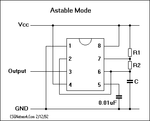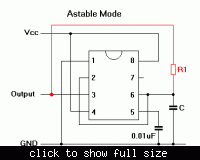Faddei
Junior Member level 2

Hi
i would like to make an frequency generator using a 555 timer chip. The frequency should vary in the range of 100hz to 1kHz with a reasonable duty cycle (20-80%). I am using the circuit below. Varying r2 alone would not do the job because at r2=0 the duty cycle is 100%.
I found out if i started with r1=2k2 and r2=4k7 and c=1uF. The freq =124hz and duty cycle is 60%.
At r1=700R r2=200R c=1uF. The freq=1309hz and the duty cycle is 81%.
But i cant find a way to change both resistors with one potentiometer. Is there a way to do that or should i use a different topology?
Thank you in advance

i would like to make an frequency generator using a 555 timer chip. The frequency should vary in the range of 100hz to 1kHz with a reasonable duty cycle (20-80%). I am using the circuit below. Varying r2 alone would not do the job because at r2=0 the duty cycle is 100%.
I found out if i started with r1=2k2 and r2=4k7 and c=1uF. The freq =124hz and duty cycle is 60%.
At r1=700R r2=200R c=1uF. The freq=1309hz and the duty cycle is 81%.
But i cant find a way to change both resistors with one potentiometer. Is there a way to do that or should i use a different topology?
Thank you in advance






